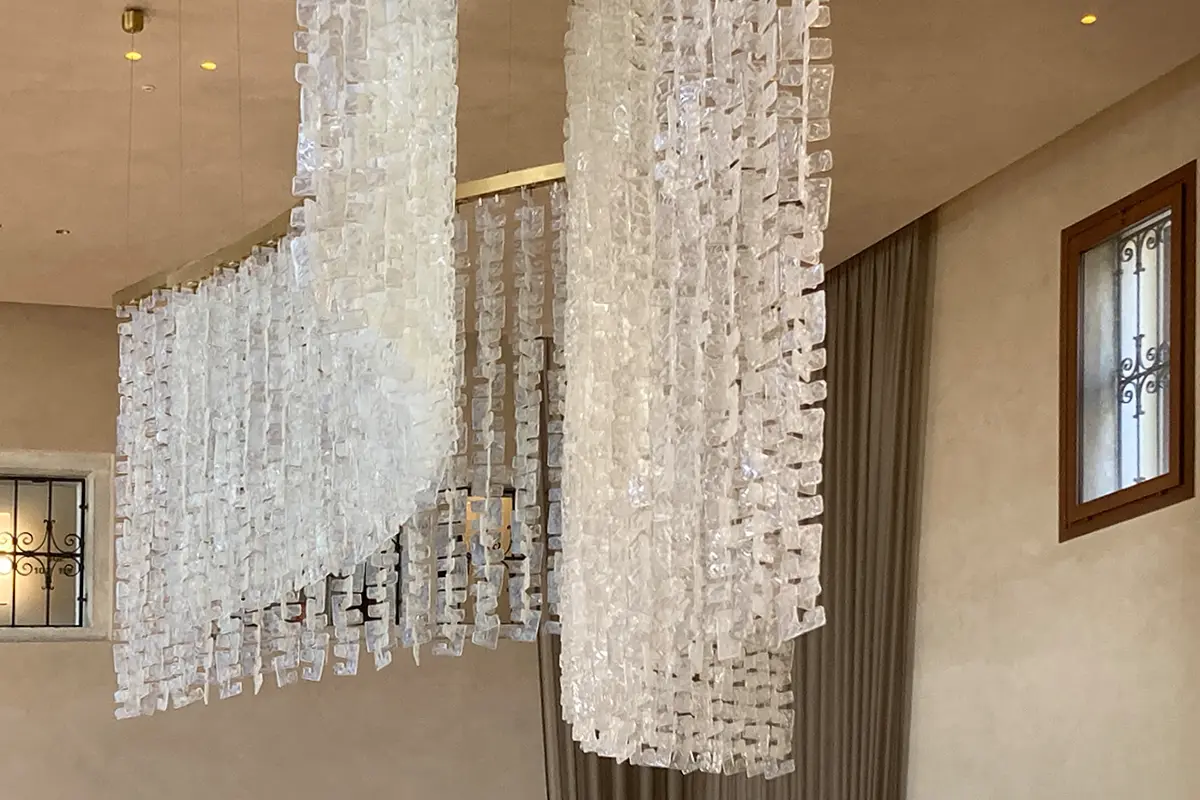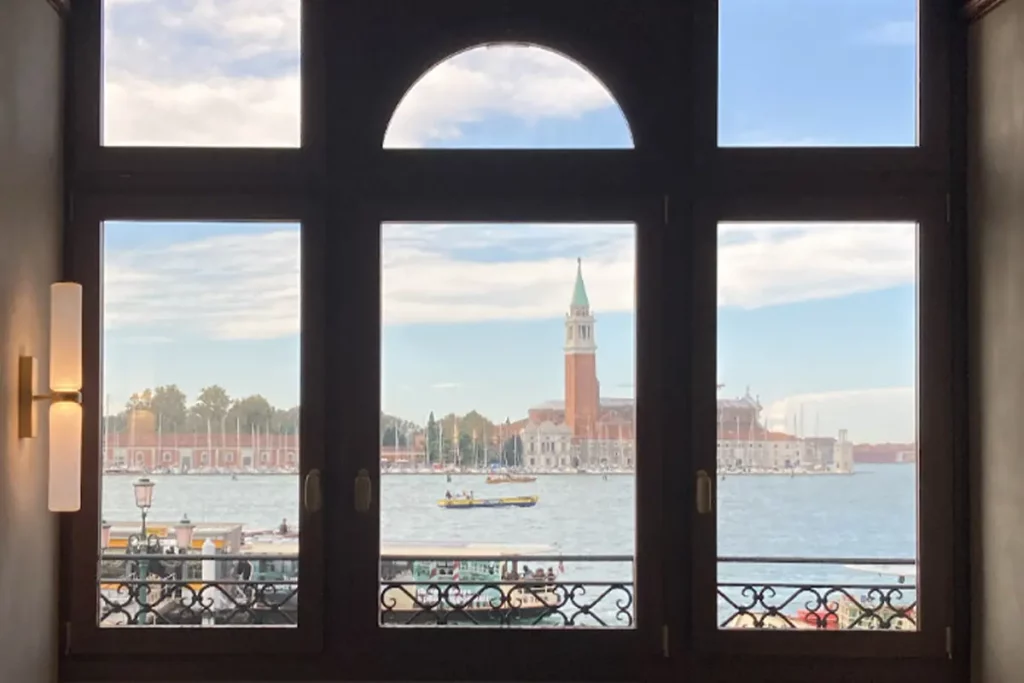Ca’ di Dio in Venice: energy savings are twenty percent less than traditional facilities, with an annual emissions reduction of about 110t/CO2 compared to conventional hot water production systems
Respecting the city legacy – Ca’ di Dio is a sustainable design hotel keen on waste reduction
The respect for the city translates into respect for the environment in which it lives. Ca’ di Dio in Venice has made investments to equip the facility with water production systems and infrastructure to limit its environmental impact. This include using lagoon water to produce the low-temperature heat transfer fluids needed for operation.
The hotel saves energy with heat recovery systems for exhaust air with abatement of emissions, alternative systems to lagoon water to be used when the temperature of the latter exceeds the minimum and maximum usage limits imposed by the Water Authority.
Ca’ di Dio and the hotel waste reduction and water production– environmental benefits in terms of CO2
Estimated energy consumption savings are about 20 percent less than other facilities and traditional facilities. Similar is the environmental benefit in terms of CO2, with a reduction of about 110t/CO2 per year of avoided emissions compared to a traditional hot water production system intended for heating.
The 5-star hotel Ca’ di Dio opened in Venice in 2021 as a member of the VRetreats group of hotels. Recently it became part of the Considerate Collection of Small Luxury Hotels of the World (SLH), in recognition of its commitment to sustainability and social impact measures.
Already part of SLH, Ca’ di Dio has succeeded in meeting the criteria of the Considerate Collection. This includes community impact, preservation of local culture, environmental awareness, and sustainability systems (as established by the Global Sustainable Tourism Council, the international non-profit established by the United Nations Environment Program).
A study on the use of surface water as a source of renewable energy has been carried out by the IUAV University of Venice. In the subject of the study, the results of monitoring over an annual period of time the performance of a heat pump using lagoon water for air conditioning of the monumental complex redeveloped for hotel use in the historic center of Venice Ca’ di Dio are presented.
From the Riviera del Brenta – uniforms Wao Nylongeconyl made by regenerated nylon from reduce the impact on waste
The focus on sustainability and the search for craftsmanship typical of the surroundings of Venice is also expressed in the staff uniforms. At Ca’ di Dio, the staff wears Wao Nylong shoes from the Riviera del Brenta company Dress to Live.
The chosen shoe is made from econyl, nylon regenerated from waste such as fishing nets, fabric scraps and industrial plastic. It has the same characteristics as virgin source nylon but reduces its impact by eighty percent on global warming. The desire to support local and sustainable realities is also present in the choice of bio-eco-sustainable sneakers for the staff of the Vero restaurant, inside the hotel.
From a House of God to a contemporary sustainable design hotel that uses recycled water production from the lagoon – a path through history at Ca’ di Dio in Venice
From an etymological point of view, Ca’ di Dio in Italian means ‘house of God’. In ancient times, Case di Dio (Houses of God) were the hospices that offered hospitality to pilgrims who stopped while waiting to reach, by sea, the Holy Sepulchre in the Holy Land or, by land, to earn indulgences in Rome – by the road called Romea for this reason. As early as the mid-thirteenth century, a hospice for pilgrims existed in Venice.
It began in 1272 the history of the palace that now houses the Venetian hotel Ca’ di Dio, which is located in the Castello district, at the entrance to the Arsenale area, also known as the ‘Contemporary Art District’ – a place associated with the International Biennale of Art. This palace overlooks St. Mark’s Basin, which over the years has lived different lives: from lodging for pilgrims passing through on their way to the Holy Land to a place that took in women in distress who were left alone. In 1544 the Procuratori de San Marco de supra initiated a complete renovation of the structure, a task they entrusted to architect Jacopo Sansovino.
On the strength of this vocation, the Venetian hotel reimagines its function today. Hospitality is no longer to the times of spiritual pilgrimages, but rather to cultural ones, in a scenario that sees modern Venice more as an international container of artistic exposition rather than a crossroads for religious wayfarers.
A sustainable design hotel: Ca’ di Dio designed by studio and designer Patricia Urquiola
In early 2019, Alpitour Group acquired the Ca’ di Dio, entrusting the entire interior design project and art direction to the studio of architect and designer Patricia Urquiola.
Patricia Urquiola has always devoted attention to the theme of a receptivity of environments capable of integrating – and sometimes, instead, alternating – local knowledge and cultures with material research; reinterpretations of a domestic dimension and enhancement of pre-existences with details aimed at achieving a uniqueness of the space experience.
«For me, curiosity is combined with the desire for things, and the desire has to be ‘friendly’: you have to feel like touching an object, you have to keep a state of mind that is never algid», Patricia Urquiola has told Domus magazine in the past.
Ca’ di Dio and the dichotomy of the two souls of Venice: Patricia Urquiola designs a modern hotel clashing with the history but aiming at respect
The concept for Ca’ di Dio was developed on the dichotomy of the two souls of Venice, two sides that seem to oppose each other but from which an encounter was born: on the one hand, the rigor of the building and the severity of the original structure, and on the other the traditional sumptuousness representative of Venetian palaces. Studio Patricia Urquiola’s research is characterized by materials and colors that speak of Venice, its craftsmen, historical heritage, and natural context. Everything is oriented toward gradations and shades, rather than colors, transparencies that recall the reflections of water.
The idea is to contrast and combine the Venice of sconte, hidden calle – meaning street in Venetian and Spanish – made of old bricks, with the Venice of noble palaces with marble and decorations. To continue the relationship with the place, materials representative of the city and its tradition were chosen, such as glass, wood, wrought iron, stone and marble.
Finishes, details and decorative elements – Ca’ di Dio’s interior design by Patricia Urquiola takes inspiration from the legacy of Venetian artisans and the city-based modern companies
For the creation of decorative, architectural and lighting elements, companies were selected local artisans to emphasize a link with the territory, such as those made in Lorenzo Panisson’s LP Glass Murano glassworks, the large chandelier in the lobby, the wall sconces and floor lamps made of glass blown in the glassworks to a design by the Urquiola studio; but also the traditional Venetian fabrics curated by Rubelli, a Venetian family business that has been producing and since 1889 high quality furniture products.
Other local companies such as Gambaro Vetri in collaboration with Vetroarredamento, Alessandro Morelli’s Europavimenti, and the finishes, marmorini, stucco, glazes and grasselli executed by Enrico Nali’s Edilia with Calce of Brenta.
Whereas the facades of the building form the osmotic membrane with which it dialogues with the rhythm of the city, the inner part of the hotel hides a different dimension. In the courtyard the sounds are those typical of a home, intimate and placid. Emphasis was also placed on the constituent materials for the courtyard, respecting the historical value: there are two original welling tubes and bricks, laid in a herringbone pattern, trace the main paths, while green areas intersperse an area dedicated to small lounges and a second natural area, an extension of the indoor restaurant.
Ca’ di Dio, VRetreats group – a recycle-friendly, sustainable hotel design in Venice tap water and water production
Ca’ di Dio is a Venetian palace located in Venice. Located at the entrance to the Arsenale district, where the Art Biennale is held, Ca’ di Dio is a building dating back to 1272. Drawing water directly from the lagoon to power the heat exchanger and cooling system, Ca’ di Dio is environmentally conscious.
Tap water is filtered, cooled, and served in glass bottles in the restaurant, which sources herbs from the herb garden, while Ca’ di Dio’s bespoke bags and boutique stationery are made from reclaimed materials from the hotel’s construction, including recycled wallpaper as notebook covers. Guests are encouraged to explore the lagoon by rowing boat or aboard hybrid electric water cabs.




















